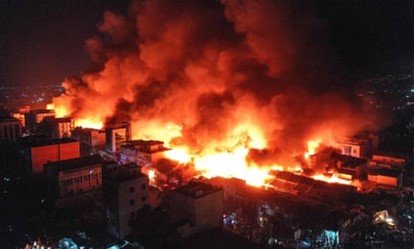On April 01st, 2022, the Waheen Market in Hargeisa, Somaliland, was engulfed in flames. The fire destroyed dozens of shops, kiosks, and warehouses, leaving many traders and their families without a source of income. One year later, the scars of the fire remain, but the city and its people are slowly rebuilding and learning from the disaster.
Causes of the Fire
The exact cause of the Waaheen Market fire is still unknown, but it is believed to have started in one of the shops and quickly spread due to the following factors:
- Combustible materials: The market was filled with flammable goods, such as clothes, electronics, and plastic products, which made the fire difficult to control and extinguish.
- Lack of fire safety measures: The market lacked proper fire safety equipment, such as fire alarms, sprinkler systems, and fire extinguishers, which could have prevented the fire from spreading and causing more damage.
- Narrow alleys: The market had narrow alleys that hindered the access of fire trucks and emergency services, which delayed the response time and allowed the fire to spread further.

What's Now Happening
In the aftermath of the fire, the Somaliland government and international aid organizations provided emergency relief to the affected traders and their families. The government also launched an investigation into the causes of the fire and pledged to improve the fire safety standards in the markets and public places. Within the DANWADAAG programme, VNG International has taken a significant step towards strengthening the social contract through transparent Disaster Risk Management. In 2022, VNG International has extended its support to the Hargeisa Municipality in Somaliland, by assisting them in the establishment of a Disaster Risk Management (DRM) Unit. This unit will be responsible for managing all disaster and risk-related matters in the districts and has the following responsibilities:
- Conducting risk assessments and developing contingency plans for potential disasters, such as floods, droughts, and epidemics.
- Coordinating with relevant stakeholders, such as the fire department, police, health authorities, and NGOs, to ensure effective response and recovery.
- Providing training and awareness-raising activities for the public and staff on disaster risk reduction and emergency preparedness.
VNG International takes great pride in its partnership with the local governments of Hargeisa and Burao and is thrilled to be part of their journey towards creating a DRM unit for the first time. The establishment of this unit is a crucial step towards ensuring the safety and well-being of the citizens of Hargeisa and Burao, and it will go a long way in mitigating the risks of natural disasters and other emergencies.
Lessons to be Learned
The Waaheen Market fire serves as a stark reminder of the urgent need to improve the resilience of cities and communities to natural and man-made disasters. Some lessons that can be learnt from the fire are:
- Fire safety should be a top priority in public places, markets, and residential buildings. This includes regular inspections, maintenance, and training of the staff and the public on fire prevention and response.
- Urban planning and design should consider the needs and safety of the residents and businesses. This includes wider and accessible streets, green spaces, and public services that can help reduce the risk of disasters and improve the quality of life.
- Building codes and regulations should be enforced to ensure that buildings are constructed and maintained to withstand potential hazards such as fire, earthquakes, and floods. This includes the use of fire-resistant materials, sprinkler systems, and emergency exits.
- Public-private partnerships and community participation can help create a culture of safety and resilience, where all stakeholders work together to identify and mitigate risks, share information and resources, and support each other during and after disasters.
These lessons will be considered within the newly established DRM Units, which hopefully should avoid similar disasters in the future.

